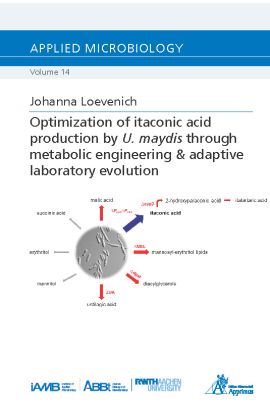The incessant growth of the world population leads to an already gigantic and still increasing demand for food, energy, fuels, and chemicals. With the finiteness of fossil resources as main feedstocks, a change from petroleum-derived to sustainable, economically bio-based production processes is indispensable to accomplish the global needs. One of these processes is the production of itaconic acid. Besides the filamentous fungus Aspergillus terreus, Ustilago maydis of the Ustilaginaceae family attracted special attention as production host.
To establish an U. maydis itaconate production host competitive to A. terreus, two strategies were chased in this thesis: metabolic engineering and adaptive laboratory evolution. By the reduction of the diverse by-product spectrum of U. maydis combined with the upregulation of the itaconate biosynthesis gene cluster regulator, the flow of substrate could be extensively pushed towards itaconate biosynthesis. This lead to an itaconate titer increased by 10.2-fold compared to the wildtype.
In this by-product reduced U. maydis strain, further metabolic engineering steps were performed: filamentous growth prevention by fuz7 deletion and overexpression of mttA encoding for the A. terreus mitochondrial tricarboxylate transporter. By ∆fuz7, the designed strain was able to produce itaconate with improved production parameters. This could even be outplayed by additional PetefmttA insertion. A clone with three PetefmttA copies reached an itaconate titer of 54 g L-1 and a maximal yield of 0.64 gITA gglu-1, which corresponds to 89 % of the theoretical value.
The great itaconate production improvements imply a higher metabolic and osmotic stress level for the cells. Adaptive laboratory evolution was used to generate a strain with increased low pH and product resistance to itaconate. The fitness of U. maydis could be significantly improved represented by strains able to grow at pH 4 and in the presents of 40 g L-1 itaconate. The consolidation of all major modifications identified in this thesis in one strain, though, resulted in a loss of this tolerance. Especially the deletion of triacylglycerol production, the cells rely on as main energy reserves, seems to destabilize the cells in the long term.
However, the results clearly illustrate that the final engineered strains feature great, far optimized itaconate production parameters close to the theoretical maximum making U. maydis an industrial relevant production host for itaconic acid.
| Autor | Loevenich, Johanna |
|---|---|
| Lieferzeit | 3-4 Tage |
| Gewicht | 0.232 kg |
| Erscheinungsdatum | 20.12.2019 |
Institut für Angewandte Mikrobiologie (iAMB)
Optimization of itaconic acid production by U. maydis through metabolic engineering & adaptive laboratory evolution
Kurzbeschreibung
This thesis focused on the fungus Ustilago maydis as natural itaconic acid producer. Two strategies were chased to improve its production performance: metabolic engineering and adaptive laboratory evolution. The final engineered strains feature great, far optimized itaconate production parameters making U. maydis an industrial relevant production host for this value-added chemical from biomass.

